Theories of Employment and Income Notes12th Economics
12th Economics Lesson 3 Notes in English
3. Theories of Employment and Income
| “Unemployed people suffer the demoralization, frustration and loss of self respect that come from enforced idleness”. – Wonnacott. P and Wonnacott. R |
Introduction
- The economic history has shown many countries facing economic problems.
- Out of these problems, unemployment is the most vexing.
- Both classical economists and Keynes have explained the relationship between employment and income.
- The classical economists had great faith in the law of markets articulated by J.B. Say, the French economist.
- J. M. Keynes is one of the greatest and most influential economists of the mid 20th century.
Meaning of Full Employment
- Full employment refers to a situation in which every able bodied person who is willing to work at the prevailing wage rate, is employed.
- In other words full employment means that persons who are willing to work and able to work must have employment or a job;
- Keynes defines full employment as the absence of involuntary unemployment.
- Lerner defines full employment as “that level of employment at which any further increase in spending would result in an inflationary spiral of wages and prices”.
- Every economy in the world aims at attaining the level of full employment equilibrium where all its available resources are fully and efficiently employed to achieve maximum level of output.
- But in reality, the concept of full employment generally refers to full employment of labour force of a country.
Unemployment and its types
- Unemployment is problem faced when there are people, who are willing to work and able to work but cannot find suitable jobs.
- While formulating policies to solve the problem of unemployment in India for instance, we need to distinguish between the nature of unemployment in rural areas and in urban areas in India.
- India’s rural economy has both unemployment and underemployment.
- The major feature of rural unemployment is the existence of unemployment in the form of disguised unemployment and seasonal unemployment.
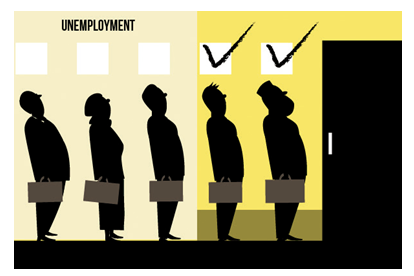
- In India, frictional, structural and open unemployment exist in urban areas.
- Due to urbanization, a large number of people move from rural areas to urban areas.
- This migration from rural to urban areas increases the size of labour force in urban areas and adds to the already unemployed labour force.
Types of Unemployment:
- In developing countries like India, the nature of unemployment is different from that of developed countries.
- In developed countries, the unemployment is purely temporary or cyclical or frictional.
- But in the developing countries, it is largely structural unemployment which is due to slow rate of capital formation.
- The following are the types of unemployment.
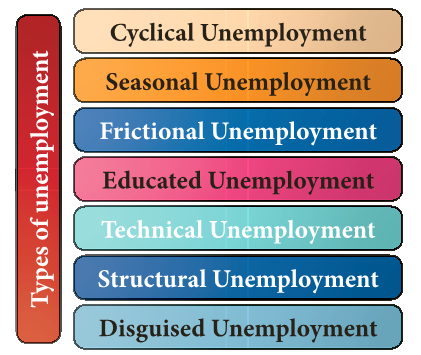
1. Cyclical Unemployment
- This unemployment exists during the downturn phase of trade cycle in the economy.
- In a business cycle during the period of recession and depression, income and output fall leading to widespread unemployment.
- It is caused by deficiency of effective demand.
- Cyclical unemployment can be cured by public investment or expansionary monetary policy.
2. Seasonal Unemployment
- This type of unemployment occurs during certain seasons of the year.
- In agriculture and agro based industries like sugar, production activities are carried out only in some seasons.
- These industries offer employment only during that season in a year.
- Therefore people may remain unemployed during the off season.
- Seasonal unemployment happens from demand side also; for example ice cream industry, holiday resorts etc.
3. Frictional Unemployment (Temporary Unemployment)
- Frictional unemployment arises due to imbalance between supply of labour and demand for labour.
- This is because of immobility of labour, lack of necessary skills, break down of machinery, shortage of raw materials etc.
- The persons who lose jobs and in search of jobs are also included under frictional unemployment.
4. Educated Unemployment
- Sometimes educated people are underemployed or unemployed when qualification does not match the job.
- Faulty education system, lack of employable skills, mass student turnout and preference for white collar jobs are highly responsible for educated unemployment in India.
5. Technical Unemployment
- Modern technology being capital intensive requires less labourers and contributes to technological unemployment.
- Now a days, invention and innovations lead to the adoption of new techniques there by the existing workers are retrenched.
- Labour saving devices are responsible for technological unemployment.
6. Structural Unemployment
- Structural unemployment is due to drastic change in the structure of the society.
- Lack of demand for the product or shift in demand to other products cause this type of unemployment.
- For example rise in demand for mobile phones has adversely affected the demand for cameras, tape recorders etc.
- So this kind of unemployment results from massive and deep rooted changes in economic structure.
7. Disguised Unemployment
- Disguised unemployment occurs when more people are there than what is actually required.
- Even if some workers are withdrawn, production does not suffer.
- This type of unemployment is found in agriculture.
- A person is said to be disguisedly by unemployed if his contribution to output is less than what he can produce by working for normal hours per day.
- In this situation, marginal productivity of labour is zero or less or negative.

Classical Theory of Employment
- There was no single theory which could be labeled as classical theory of employment.
- The classical theory of employment is composed of different views of classical economists on the issue of income and employment in the economy.
- Adam smith wrote the book “An Enquiry into the Nature and Causes of the Wealth of Nations’ in 1776.
- Since the publication of this book, classical theory was developed by David Ricardo, J.S. Mill, J.B. Say and A.C. Pigou.
- Classical economists assumed that the economy operates at the level of full employment without inflation in the long period.
- They also assumed that wages and prices of goods were flexible and the competitive market existed in the economy (laissez-faire economy).
Say’s Law of Market

- Say’s law of markets is the core of the classical theory of employment.
- J.B. Say (1776 – 1832) was a French Economist and an industrialist.
- He was influenced by the writings of Adam Smith and David Ricardo. J.B. Say enunciated the proposition that “Supply creates its own demand”.
- Hence there cannot be general over production or the problem of unemployment in the economy.
- According to Say, “When goods are produced by firms in the economy, they pay reward to the factors of production.
- The households after receiving rewards of the factors of production spend the amount on the purchase of goods and services produced by them.
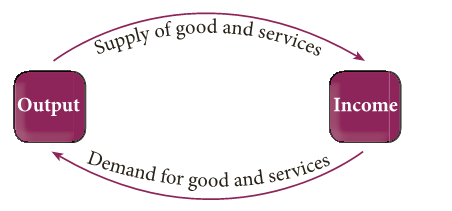
- Therefore, each product produced in the economy creates demand equal to its value in the market.
- In short, this classical theory explains that “A person receives his income from production which is spent on the purchase of goods and services produced by others.
- For the economy as a whole, therefore, total production equals total income”.
Assumptions of the Say’s law of market
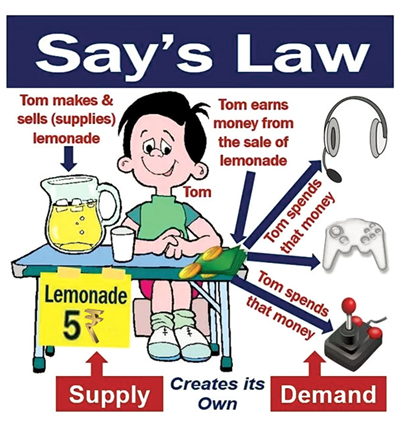
- The Say’s Law of market is based on the following assumptions:
- No single buyer or seller of commodity or an input can affect price.
- Full employment.
- People are motivated by self interest and self – interest determines economic decisions.
- The laissez faire policy is essential for an automatic and self adjusting process of full employment equilibrium. Market forces determine everything right.
- There will be a perfect competition in labour and product market.
- There is wage-price flexibility.
- Money acts only as a medium of exchange.
- Long – run analysis.
- There is no possibility for over production or unemployment.
- Unutilized resources used until reaches full employment.
- No Government intervention automatic Price adjustment mechanism operated.
- Interest rate flexibility leads is saving – Investment equality
Implications of Say’s Law
- There is no possibility for over production or unemployment.
- If there exist unutilized resources in the economy, it is profitable to employ them up to the point of full employment. This is true under the condition that factors are willing to accept rewards on a par with their productivity.
- As automatic price mechanism operates in the economy, there is no need for government intervention. (However, J.M. Keynes emphasized the role of the State)
- Interest flexibility brings about equality between saving and investment.
- Money performs only the medium of exchange function in the economy, as people will not hold idle money.
Criticisms of Say’s Law
- The following are the criticisms against Say’s law:
- According to Keynes, supply does not create its demand. It is not applicable where demand does not increase as much as production increases.
- Automatic adjustment process will not remove unemployment. Unemployment can be removed by increase in the rate of investment.
- Money is not neutral. Individuals hold money for unforeseen contingencies while businessmen keep cash reserve for future activities.
- Say’s law is based on the proposition that supply creates its own demand and there is no over production. Keynes said that over production is possible.
- Keynes regards full employment as a special case because there is under – employment in capitalist economies.
- The need for state intervention arises in the case of general over production and mass unemployment.
Keynes’ Theory of Employment and Income
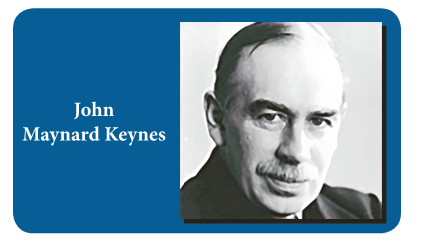
- Keynes’ book, “The General Theory of Employment, Interest and Money” published in 1936 is a highly significant work that marked a turning point in the development of modern economic theory.
- The theory of Keynes was against the belief of classical economists that the market forces in capitalist economy adjust themselves to attain equilibrium.
- Keynes not only criticized classical economists but also advocated his own theory of employment.
- Keynes’ theory was a general theory as it tried to explain all types of situations, i.e. not only equilibrium level of employment but also the concept of full employment as well as the possibility of underemployment.
- Keynes theory of employment was based on the view of the short run.
- According to him, the factors of production such as capital goods, supply of labour, technology and efficiency of labour remain unchanged while determining the level of employment.
Effective Demand
- The starting point of Keynes theory of employment and income is the principle of effective demand.
- Effective demand denotes money actually spent by the people on products of industry.

- The money which entrepreneurs receive is paid in the form of rent, wages, interest and profit.
- Therefore effective demand equals national income. An increase in the aggregate effective demand would increase the level of employment.
- A decline in total effective demand would lead to unemployment.
- Therefore, total employment of a country can be determined with the help of total demand of a country.
- According to the Keynes theory of employment, “Effective demand signifies the money spent on consumption of goods and services and on investment.
- The total expenditure is equal to the national income, which is equivalent to the national output”.
- The relationship between employment and output of an economy depends upon the level of effective demand which is determined by the forces of aggregate supply and aggregate demand.
| ED = Y = C + I = Output = Employment |
- Effective demand determines the level of employment in the economy. When effective demand increases, employment will increase.
- When effective demand decreases, the level employment will decline.
- The effective demand will be determined by two determinants namely consumption and investment expenditures.
- The consumption function depends upon income of the people and marginal propensity to consume.
- According to Keynes, if income increases, consumption will also increase but by less than the increase in income.
- The rate of interest and marginal efficiency of capital determine the investment levels.
- Rate of interest depends on money supply and liquidity preference. Keynes has given importance to the concept of liquidity preference.
- Liquidity preference is based on three motives namely transaction motive, precautionary motive and speculative motive.
- MEC depends on two factors namely prospective yield of capital asset and supply price of capital.
Aggregate Demand Function (ADF)
- In the Keynesian model, output is determined mainly by aggregate demand.
- The aggregate demand is the amount of money which entrepreneurs expect to get by selling the output produced by the number of labourers employed.
- Therefore, it is the expected income or revenue from the sale of output at different levels of employment.
- Aggregate demand has the following four components:
- Consumption demand
- Investment demand
- Government expenditure and
- Net Export ( export – import )
- The desired or planned demand (spending) is the amount that households, firms, the governments and the foreign purchasers would like to spend on domestic output.
- In other words, desired demand in the economy is the sum total of desired private consumption expenditure, desired investment expenditure, desired government spending and desired net exports (difference between exports and imports).
- Thus, the desired spending is called aggregate spending (demand), and can be expressed as:
| AD = C + I + G + (X – M) |
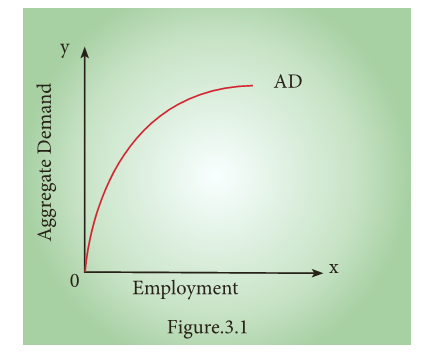
- Figure 3.1. explains that aggregate demand price increases or decreases with an increase or decrease in the volume of employment.
- Aggregate demand curve increases at an increasing rate in the beginning and then increases at a decreasing rate.
- This shows that as income increases owing to increase in employment, expenditure of the economy increases at a decreasing rate.
Aggregate Supply Function (ASF)
- Aggregate supply function is an increasing function of the level of employment.
- Aggregate supply refers to the value of total output of goods and services produced in an economy in a year.
- In other words, aggregate supply is equal to the value of national product, i.e., national income.
- In other words, the aggregate supply refers to the required amount of labourers and materials to produce the necessary output.
- Employers hire labourers, purchase various inputs and raw materials to produce goods. Thus, production involves cost.
- If revenue from the sale of output produced exceeds the cost of production at a given level of employment and output, the entrepreneur would be encouraged to employ more labour and other inputs to produce more.
- Aggregate supply price is the total amount of money that all entrepreneurs in an economy expect to receive from the sale of output produced by given number of labourers employed.
- The term ‘price’ refers to the amount of money received from the sale of output (sales proceeds).
- Hence, there are different aggregate prices for different levels of employment. The components of aggregate supply are :
- Aggregate (desired) consumption expenditure (C)
- Aggregate (desired) private savings (S)
- Net tax payments (T) (Total tax payment to be received by the government minus transfer payments, subsidy and interest payments to be incurred by the government) and
- Personal (desired) transfer payments to the foreigners (Rf) (eg. Donations to international relief efforts)
| Aggregate Supply = C + S + T + Rf = Aggregate income generated in the economy |
- The following figure 3.2 shows the shape of the two aggregate supply curves drawn for the assumption of fixed money wages and variable wages.
AGGREGATE SUPPLY CURVE
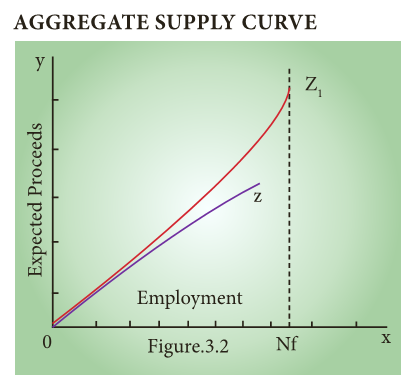
- Z curve is linear where money wages remains fixed; Z1 curve is non – linear since wage rate increases with employment.
- When full employment level of Nf is reached it is impossible to increase output by employing more men.
- So aggregate supply curve becomes inelastic (Vertical straight line).
- The slope of the aggregate supply curve depends on the relation between the employment and productivity.
- The capital stock is often fixed and hence the law of diminishing marginal returns takes place as more workers are employed.
- Based upon this relation, the aggregate supply curve can be expected to slope upwards.
- In reality the aggregate supply curve will be like Z1 in figure 3.2. Therefore, the aggregate supply depends on the relationship between price and wages.
- If prices are high and wages low, the producers will try to employ labourers.
- If prices are low and wages high, investment will be curtailed, output will fall and there will be a reduction in the productive capacity.
- Thus aggregate supply is an important factor in determining the level of economic activity.
Equilibrium between ADF and ASF
- Under the Keynes theory of employment, a simple two sector economy consisting of the household sector and the business sector is taken to understand the equilibrium between ADF and ASF.
- All the decisions concerning consumption expenditure are taken by the individual households, while the business firms take decisions concerning investment.
- It is also assumed that consumption function is linear and planned investment is autonomous.
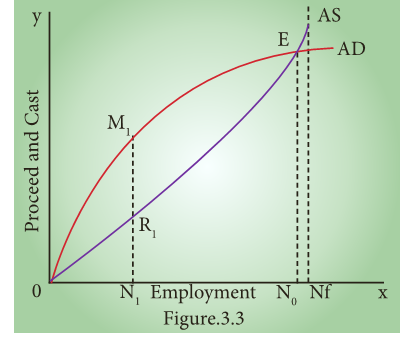
- There are two approaches to determination of the equilibrium level of income in Keynesian theory. These are :
- Aggregate demand – Aggregate supply approach
- Saving – Investment approach
- In this chapter, out of these two, aggregate demand and aggregate supply approach is alone explained to understand the determination of equilibrium level of income and employment.
- The concept of effective demand is more clearly shown in the figure 3.3
- In the figure, the aggregate demand and aggregate supply reach equilibrium at point E.
- The employment level is No at that point. At O N1 employment, the aggregate supply is N1 R1. But they are able to produce M1 N1.
- The expected level of profit is M1 R1.
- To attain this level of profit, entrepreneurs will employ more labourers.
- The tendency to employ more labour will stop once they reach point E.
- At all levels of employment beyond, O No, the aggregate demand curve is below the aggregate supply curve indicating loss to the producers. Hence they will never employ more than O No labour.
- Thus effective demand concept becomes a crucial point in determining the equilibrium level of output in the capitalist economy or a free market economy in the Keynesian system.
- It is important to note that the equilibrium level of employment need not be the full employment level (N1) from the Figure 3.3, it is understood that the difference between No – Nf is the level of unemployment.
- Thus the concept of effective demand becomes significant in explaining the under employment equilibrium.
Comparison of Classicism and Keynesianism
| Sl.No | Keynesianism | Classicism |
| 1 | Short-run equilibrium | Long-run equilibrium |
| 2 | Saving is a vice | Saving is a social virtue. |
| 3 | The function of money is a medium of exchange on the one side and a store of value on the other side. | The function of money is to act as a medium of exchange |
| 4 | Macro approach to national problems | Micro foundation to macro problems |
| 5 | State intervention is advocated. | Champions of Laissez-fair policy |
| 6 | Applicable to all situations – full employment and less than full employment. | Applicable only to the full employment situation. |
| 7 | Capitalism has inherent contradictions | Capitalism is well and good. |
| 8 | Budgeting should be adjusted to the requirements of economy. | Balanced budget |
| 9 | The equality between saving and investment is advanced through changes in income. | The equality between saving and investment is achieved through changes of rate of interest. |
| 10 | Rate of interest is determined by the demand for and supply of money. | Rate of interest is determined by saving and investment. |
| 11 | Rate of interest is a flow. | Rate of interest is a stock. |
| 12 | Demand creates its own supply. | Supply creates its own demand. |
| 13 | Rate of interest is a reward for parting with liquidity. | Rate of interest is a reward for saving. |
- After learning so much about the theories of employment and income, it is pertinent to look at what is employment multiplier.
MORE TO KNOW:
Exante and Expost in Says’ Law
- The statement that supply creates own demand or equivalently that the aggregate investment equals the aggregate saving always holds good in the ex post sense since it is simply an accounting identity.
- Say’s law of markets, however, states that these two are equal in ex ante sense, i.e., the total quantity which people produce i.e., aggregate supply must be equal to the total quantity which they plan to buy i.e., aggregate demand.
John Maynard Keynes
- John Maynard Keynes was one of the most influential economists of the 20th century. He was born in Cambridge in1883.
- In addition to his work as an economist he held position as civil servant a director of the Bank of England, and leader of British delegation of negotiators at the Bretton Woods conference at points in his career.
- Economic theory based on his idea is known as Keynesian economics, and remain highly influential today, particularly in the field of macroeconomics.
- Keynes challenged the classical economic theory regarding the merits of state intervention in markets and led to widespread shift in both economic theory and government policies worldwide in the post World War II period.
